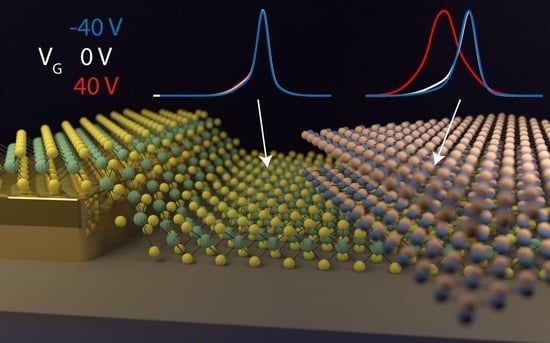Enhanced Field-Effect Control of Single-Layer WS2 Optical Features by hBN Full Encapsulation
Abstract
1. Introduction
2. Results and Discussions
3. Conclusions
Supplementary Materials
Author Contributions
Funding
Data Availability Statement
Conflicts of Interest
References
- Qiu, D.Y.; da Jornada, F.H.; Louie, S. G Optical Spectrum of MoS2: Many-Body Effects and Diversity of Exciton. Phys. Rev. Lett. 2013, 111, 216805. [Google Scholar] [CrossRef] [PubMed]
- Cheiwchanchamnangij, T.; Lambrecht, W.R.L. Quasiparticle Band Structure Calculation of Monolayer, Bilayer, and Bulk MoS2. Phys. Rev. B Condens. Matter Mater. Phys. 2012, 85, 205302. [Google Scholar] [CrossRef]
- Ramasubramaniam, A.A. Large Excitonic Effects in Monolayers of Molybdenum and Tungsten Dichalcogenides. Phys. Rev. B Condens. Matter Mater. Phys. 2012, 86, 115409. [Google Scholar] [CrossRef]
- Mueller, T.; Malic, E. Exciton Physics and Device Application of Two-Dimensional Transition Metal Dichalcogenide Semiconductors. Npj 2D Mater. Appl. 2018, 2, 2. [Google Scholar] [CrossRef]
- Van Tuan, D.; Scharf, B.; Wang, Z.; Shan, J.; Mak, K.F.; Žutić, I.; Dery, H. Probing Many-Body Interactions in Monolayer Transition-Metal Dichalcogenides. Phys. Rev. B 2019, 99, 085301. [Google Scholar] [CrossRef]
- Xiao, K.; Yan, T.; Liu, Q.; Yang, S.; Kan, C.; Duan, R.; Liu, Z.; Cui, X. Many-Body Effect on Optical Properties of Monolayer Molybdenum Diselenide. J. Phys. Chem. Lett. 2021, 12, 2555. [Google Scholar] [CrossRef]
- Rivera, P.; Schaibley, J.R.; Jones, A.M.; Ross, J.S.; Wu, S.; Aivazian, G.; Klement, P.; Seyler, K.; Clark, G.; Ghimire, N.J.; et al. Observation of Long-Lived Interlayer Excitons in Monolayer MoSe2-WSe2 Heterostructures. Nat. Commun. 2015, 6, 6242. [Google Scholar] [CrossRef]
- Chiu, M.H.; Li, M.Y.; Zhang, W.; Hsu, W.T.; Chang, W.H.; Terrones, M.; Terrones, H.; Li, L.J. Spectroscopic Signatures for Interlayer Coupling in MoS2-WSe2 van Der Waals Stacking. ACS Nano 2014, 8, 9649. [Google Scholar] [CrossRef]
- Wang, Z.; Rhodes, D.A.; Watanabe, K.; Taniguchi, T.; Hone, J.C.; Shan, J.; Mak, K.F. Evidence of High-Temperature Exciton Condensation in Two-Dimensional Atomic Double Layers. Nature 2019, 574, 76. [Google Scholar] [CrossRef]
- Carrascoso, F.; Li, H.; Frisenda, R.; Castellanos-Gomez, A. Strain Engineering in Single-, Bi- and Tri-Layer MoS2, MoSe2, WS2 and WSe2. Nano Res. 2021, 14, 1698. [Google Scholar] [CrossRef]
- Carrascoso, F.; Frisenda, R.; Castellanos-Gomez, A. Biaxial versus Uniaxial Strain Tuning of Single-Layer MoS2. Nano Mater. Sci. 2022, 4, 44. [Google Scholar] [CrossRef]
- Peimyoo, N.; Wu, H.Y.; Escolar, J.; de Sanctis, A.; Prando, G.; Vollmer, F.; Withers, F.; Riis-Jensen, A.C.; Craciun, M.F.; Thygesen, K.S.; et al. Engineering Dielectric Screening for Potential-Well Arrays of Excitons in 2D Materials. ACS Appl. Mater. Interfaces 2020, 12, 55134. [Google Scholar] [CrossRef] [PubMed]
- Radisavljevic, B.; Radenovic, A.; Brivio, J.; Giacometti, V.; Kis, A.A. Single-Layer MoS2 Transistors. Nat. Nanotechnol. 2011, 6, 147. [Google Scholar] [CrossRef] [PubMed]
- Ross, J.S.; Wu, S.; Yu, H.; Ghimire, N.J.; Jones, A.M.; Aivazian, G.; Yan, J.; Mandrus, D.G.; Xiao, D.; Yao, W.; et al. Electrical Control of Neutral and Charged Excitons in a Monolayer Semiconductor. Nat. Commun. 2013, 4, 1474. [Google Scholar] [CrossRef]
- Mak, K.F.; He, K.; Lee, C.; Lee, G.H.; Hone, J.; Heinz, T.F.; Shan, J. Tightly Bound Trions in Monolayer MoS2. Nat. Mater. 2013, 12, 207. [Google Scholar] [CrossRef] [PubMed]
- Shang, J.; Shen, X.; Cong, C.; Peimyoo, N.; Cao, B.; Eginligil, M.; Yu, T. Observation of excitonic fine structure in a 2D transition-metal dichalcogenide semiconductor. ACS Nano 2015, 9, 647. [Google Scholar] [CrossRef]
- Egginger, M.; Bauer, S.; Schwödiauer, R.; Neugebauer, H.; Sariciftci, N.S. Current versus gate voltage hysteresis in organic field effect transistors. Mon. Fur Chem. 2009, 140, 735. [Google Scholar] [CrossRef]
- Ghatak, S.; Pal, A.N.; Ghosh, A. Nature of Electronic States in Atomically Thin MoS2 Field-Effect Transistors. ACS Nano 2011, 5, 7707. [Google Scholar] [CrossRef]
- Guo, Y.; Wei, X.; Shu, J.; Liu, B.; Yin, J.; Guan, C.; Han, Y.; Gao, S.; Chen, Q. Charge Trapping at the MoS2-SiO2 Interface and Its Effects on the Characteristics of MoS2 Metal-Oxide-Semiconductor Field Effect Transistors. Appl. Phys. Lett. 2015, 106, 103109. [Google Scholar] [CrossRef]
- Lee, C.; Rathi, S.; Khan, M.A.; Lim, D.; Kim, Y.; Yun, S.J.; Youn, D.H.; Watanabe, K.; Taniguchi, T.; Kim, G.H. Comparison of Trapped Charges and Hysteresis Behavior in HBN Encapsulated Single MoS2 Flake Based Field Effect Transistors on SiO2 and HBN Substrates. Nanotechnology 2018, 29, 335202. [Google Scholar] [CrossRef]
- Wierzbowski, J.; Klein, J.; Sigger, F.; Straubinger, C.; Kremser, M.; Taniguchi, T.; Watanabe, K.; Wurstbauer, U.; Holleitner, A.W.; Kaniber, M.; et al. Direct Exciton Emission from Atomically Thin Transition Metal Dichalcogenide Heterostructures Near the Lifetime Limit. Sci. Rep. 2017, 7, 12383. [Google Scholar] [CrossRef] [PubMed]
- Castellanos-Gomez, A.; Buscema, M.; Molenaar, R.; Singh, V.; Janssen, L.; van der Zant, H.S.J.; Steele, G.A. Deterministic Transfer of Two-Dimensional Materials by All-Dry Viscoelastic Stamping. 2D Mater. 2014, 1, 011002. [Google Scholar] [CrossRef]
- Zhao, Q.; Wang, T.; Ryu, Y.K.; Frisenda, R.; Castellanos-Gomez, A.J. An Inexpensive System for the Deterministic Transfer of 2D Materials. J. Phys. Mater. 2020, 3, 016001. [Google Scholar] [CrossRef]
- Niu, Y.; Gonzalez-Abad, S.; Frisenda, R.; Marauhn, P.; Drüppel, M.; Gant, P.; Schmidt, R.; Taghavi, N.S.; Barcons, D.; Molina-Mendoza, A.J.; et al. Thickness-Dependent Differential Reflectance Spectra of Monolayer and Few-Layer MoS2, MoSe2, WS2 and WSe2. Nanomaterials 2018, 8, 725. [Google Scholar] [CrossRef] [PubMed]
- Cong, C.; Shang, J.; Wang, Y.; Yu, T. Optical Properties of 2D Semiconductor WS2. Adv. Opt. Mater. 2018, 6, 1700767. [Google Scholar] [CrossRef]
- Ayari, A.; Cobas, E.; Ogundadegbe, O.; Fuhrer, M.S. Realization and Electrical Characterization of Ultrathin Crystals of Layered Transition-Metal Dichalcogenides. J. Appl. Phys. 2007, 101, 014507. [Google Scholar] [CrossRef]
- Plechinger, G.; Nagler, P.; Kraus, J.; Paradiso, N.; Strunk, C.; Schüller, C.; Korn, T. Identification of excitons, trions and biexcitons in single-layer WS2. Phys. Status Solidi Rapid Res. Lett. 2015, 9, 457. [Google Scholar] [CrossRef]
- Illarionov, Y.Y.; Knobloch, T.; Jech, M.; Lanza, M.; Akinwande, D.; Vexler, M.I.; Mueller, T.; Lemme, M.C.; Fiori, G.; Schwierz, F.; et al. Insulators for 2D nanoelectronics: The gap to bridge. Nat. Commun. 2020, 11, 3385. [Google Scholar] [CrossRef]
- Illarionov, Y.Y.; Rzepa, G.; Waltl, M.; Knobloch, T.; Grill, A.; Furchi, M.M.; Mueller, T.; Grasser, T. The role of charge trapping in MoS2/SiO2 and MoS2/hBN field-effect transistors. 2D Mater. 2016, 3, 035004. [Google Scholar] [CrossRef]
- Cavalcante, L.S.R.; da Costa, D.R.; Farias, G.A.; Reichman, D.R.; Chaves, A. Stark Shift of Excitons and Trions in Two-Dimensional Materials. Phys. Rev. B 2018, 98, 245309. [Google Scholar] [CrossRef]
- Zhu, B.; Chen, X.; Cui, X. Exciton Binding Energy of Monolayer WS2. Sci. Rep. 2015, 5, 9218. [Google Scholar] [CrossRef] [PubMed]
- Sun, Z.; Beaumariage, J.; Xu, K.; Liang, J.; Hou, S.; Forrest, S.R.; Fullerton-Shirey, S.K.; Snoke, D.W. Electric-Field-Induced Optical Hysteresis in Single-Layer WSe2. Appl. Phys. Lett. 2019, 115, 161103. [Google Scholar] [CrossRef]
- Huard, V.; Cox, R.T.; Saminadayar, K.; Arnoult, A.; Tatarenko, S. Bound states in optical absorption of semiconductor quantum wells containing a two-dimensional electron Gas. Phys. Rev. Lett. 2000, 84, 187. [Google Scholar] [CrossRef] [PubMed]
- Zhang, C.; Wang, H.; Chan, W.; Manolatou, C.; Rana, F. bsorption of Light by Excitons and Trions in Monolayers of Metal Dichalcogenide Mo S2: Experiments and Theory. Phys. Rev. B Condens. Matter Mater. Phys. 2014, 89, 205436. [Google Scholar] [CrossRef]
- Taghavi, N.S.; Gant, P.; Huang, P.; Niehues, I.; Schmidt, R.; de Vasconcellos, S.M.; Bratschitsch, R.; García-Hernández, M.; Frisenda, R.; Castellanos-Gomez, A. Thickness Determination of MoS2, MoSe2, WS2 and WSe2 on Transparent Stamps Used for Deterministic Transfer of 2D Materials. Nano Res. 2019, 12, 1691. [Google Scholar] [CrossRef]
- Taniguchi, T.; Watanabe, K.J. Synthesis of high-purity boron nitride single crystals under high pressure by using Ba-Bn solvent. Cryst. Growth 2007, 303, 525. [Google Scholar] [CrossRef]
- Berkdemir, A.; Gutiérrez, H.R.; Botello-Méndez, A.R.; Perea-López, N.; Elías, A.L.; Chia, C.I.; Wang, B.; Crespi, V.H.; López-Urías, F.; Charlier, J.C.; et al. Identification of individual and few layers of WS2 using Raman Spectroscopy. Sci. Rep. 2013, 3, 1755. [Google Scholar] [CrossRef]
- Castellanos-Gomez, A.; Quereda, J.; van der Meulen, H.P.; Agraït, N.; Rubio-Bollinger, G. Spatially Resolved Optical Absorption Spectroscopy of Single- and Few-Layer MoS2 by Hyperspectral Imaging. Nanotechnology 2016, 27, 115705. [Google Scholar] [CrossRef]
- Splendiani, A.; Sun, L.; Zhang, Y.; Li, T.; Kim, J.; Chim, C.Y.; Galli, G.; Wang, F. Emerging Photoluminescence in Monolayer MoS2. Nano Lett. 2010, 10, 1271. [Google Scholar] [CrossRef]
- Zhao, W.; Ghorannevis, Z.; Chu, L.; Toh, M.; Kloc, C.; Tan, P.H.; Eda, G. Evolution of Electronic Structure in Atomically Thin- Sheets of Ws 2 and Wse2. ACS Nano 2013, 7, 791. [Google Scholar] [CrossRef]
- Shree, S.; Paradisanos, I.; Marie, X.; Robert, C.; Urbaszek, B. Guide to Optical Spectroscopy of Layered Semiconductors. Nat. Rev. Phys. 2021, 3, 39. [Google Scholar] [CrossRef]
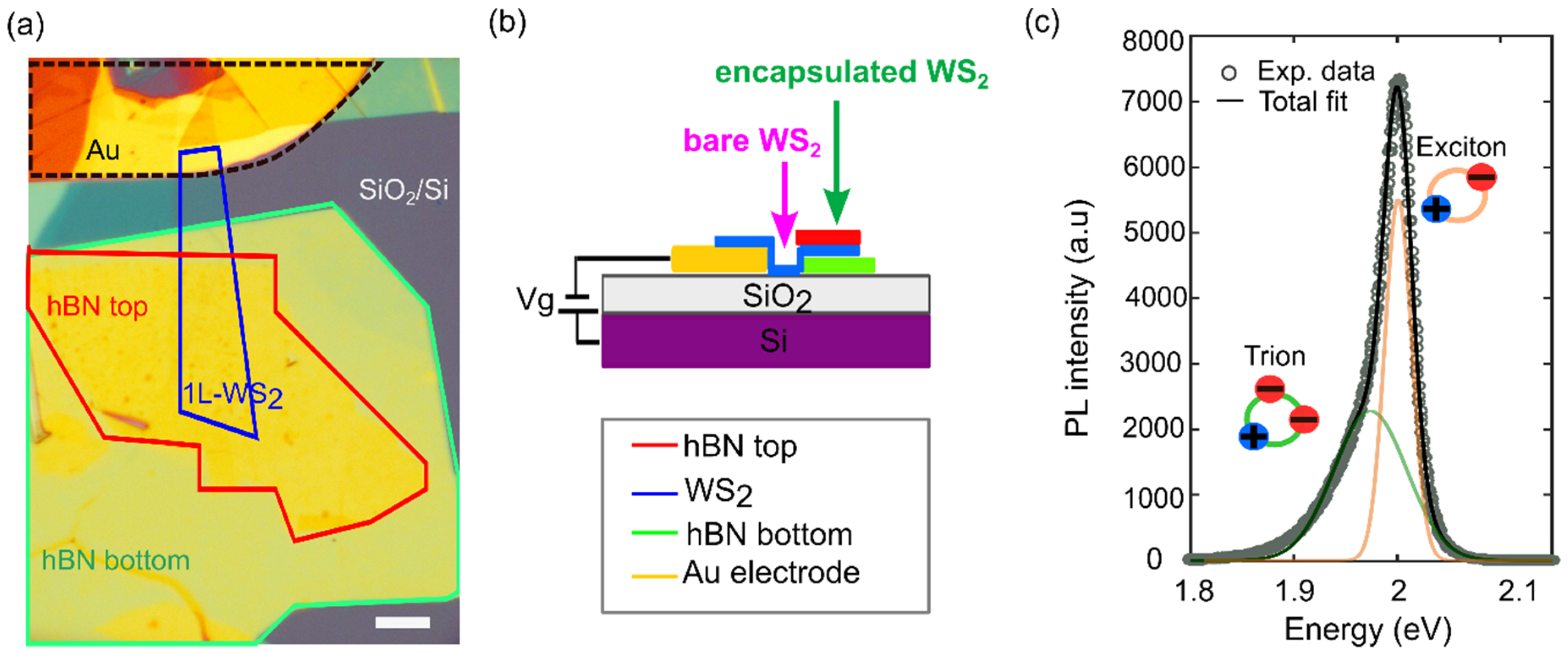
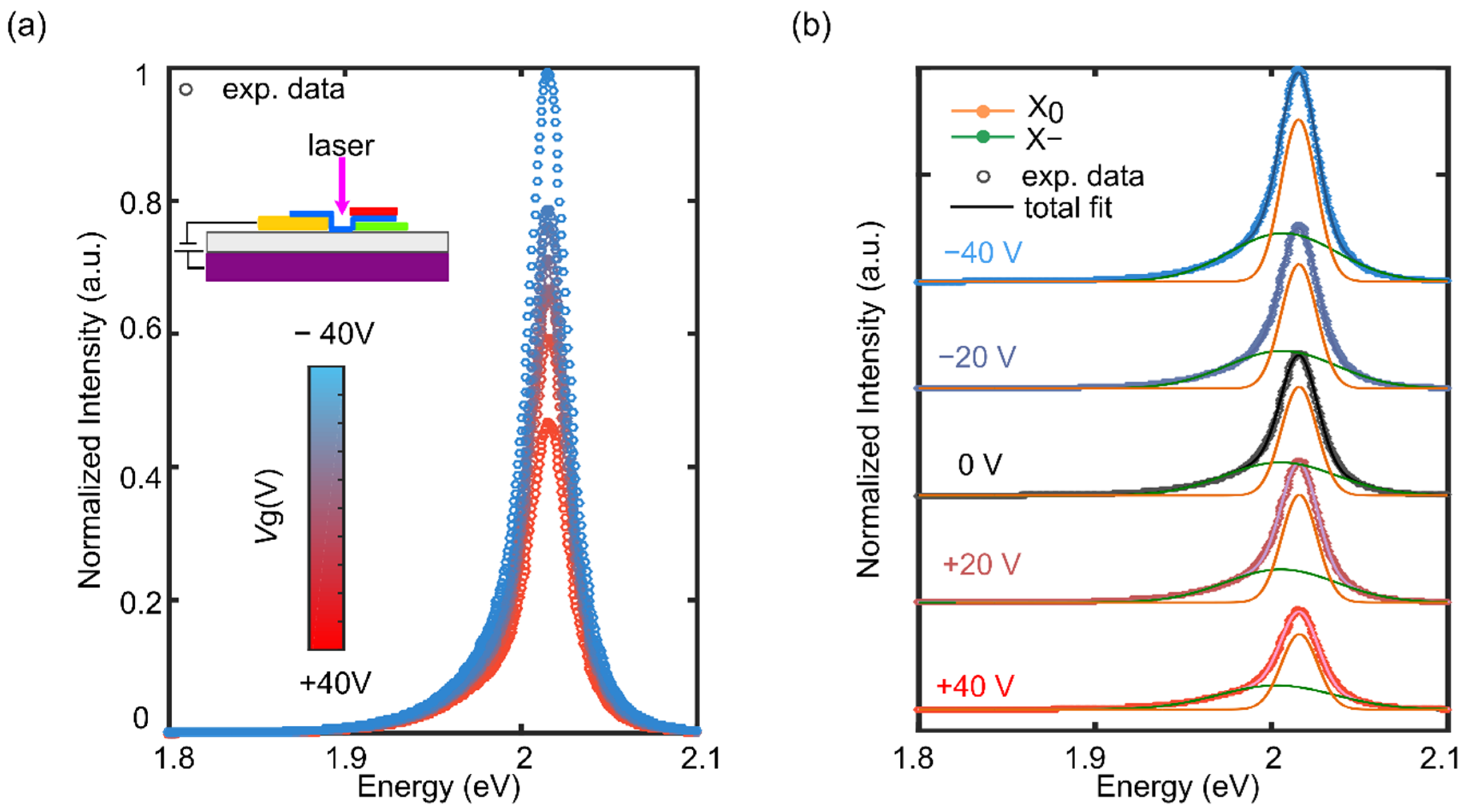

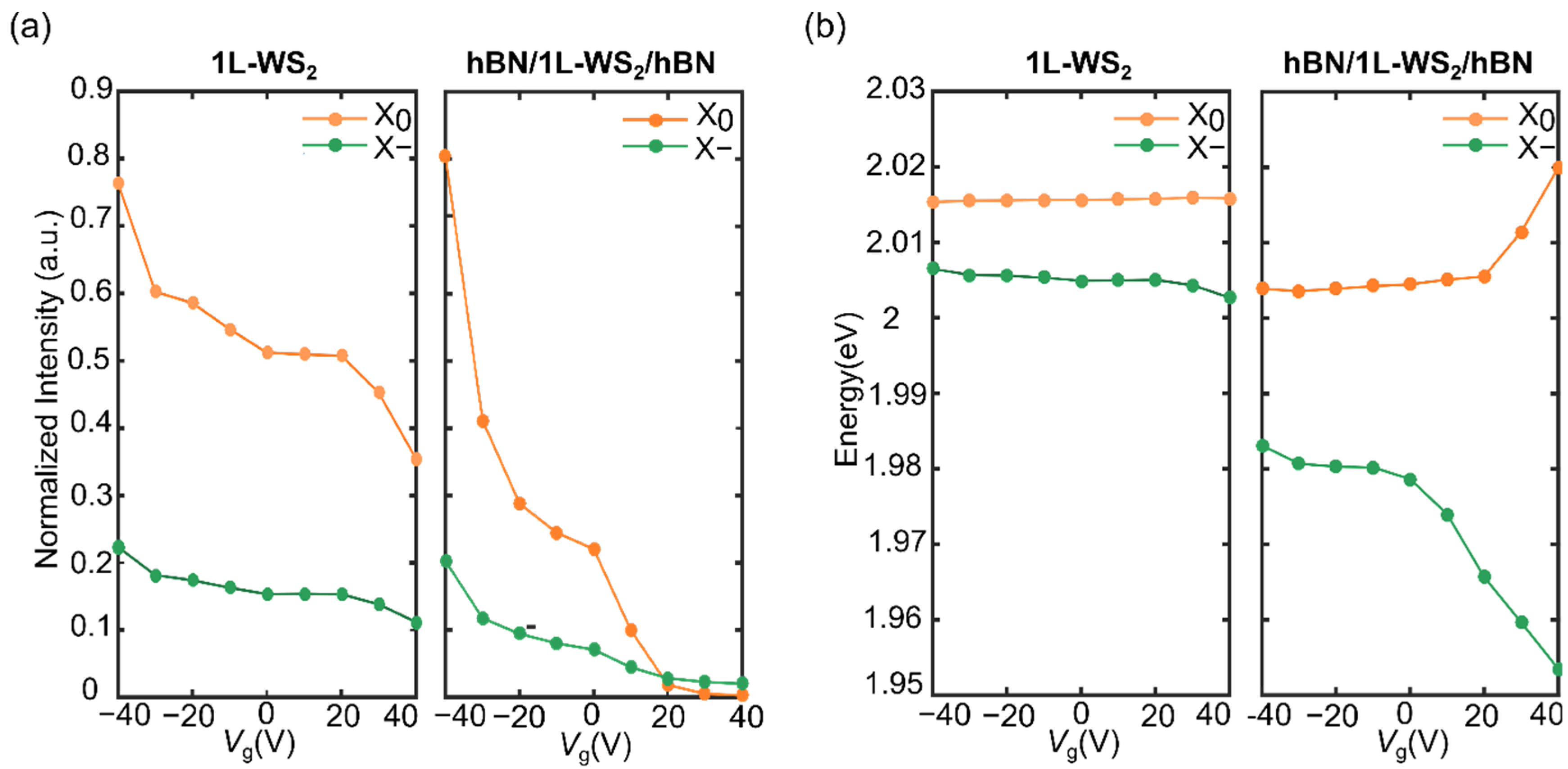
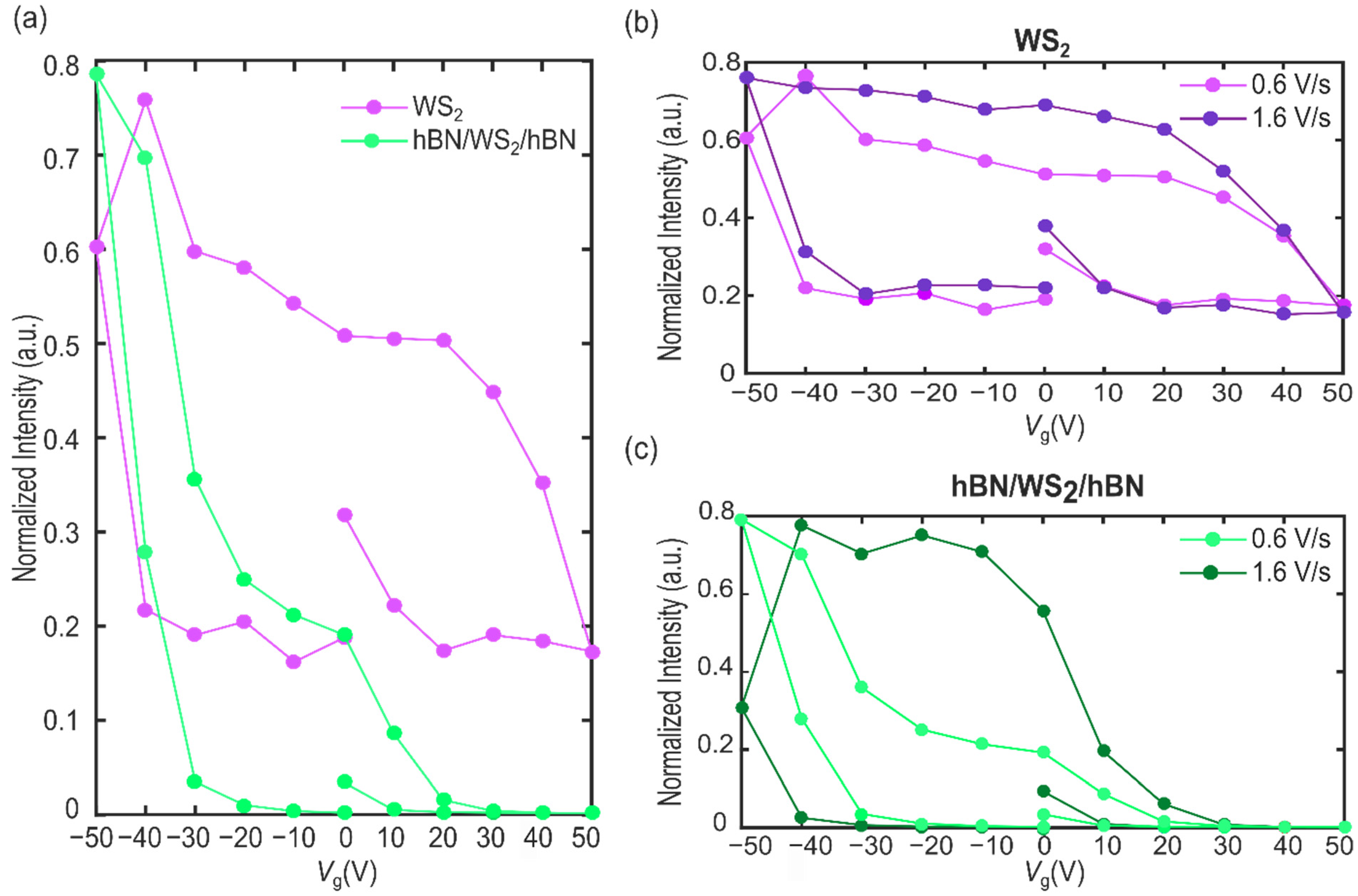
Publisher’s Note: MDPI stays neutral with regard to jurisdictional claims in published maps and institutional affiliations. |
© 2022 by the authors. Licensee MDPI, Basel, Switzerland. This article is an open access article distributed under the terms and conditions of the Creative Commons Attribution (CC BY) license (https://creativecommons.org/licenses/by/4.0/).
Share and Cite
Di Renzo, A.; Çakıroğlu, O.; Carrascoso, F.; Li, H.; Gigli, G.; Watanabe, K.; Taniguchi, T.; Munuera, C.; Rizzo, A.; Castellanos-Gomez, A.; et al. Enhanced Field-Effect Control of Single-Layer WS2 Optical Features by hBN Full Encapsulation. Nanomaterials 2022, 12, 4425. https://doi.org/10.3390/nano12244425
Di Renzo A, Çakıroğlu O, Carrascoso F, Li H, Gigli G, Watanabe K, Taniguchi T, Munuera C, Rizzo A, Castellanos-Gomez A, et al. Enhanced Field-Effect Control of Single-Layer WS2 Optical Features by hBN Full Encapsulation. Nanomaterials. 2022; 12(24):4425. https://doi.org/10.3390/nano12244425
Chicago/Turabian StyleDi Renzo, Anna, Onur Çakıroğlu, Felix Carrascoso, Hao Li, Giuseppe Gigli, Kenji Watanabe, Takashi Taniguchi, Carmen Munuera, Aurora Rizzo, Andres Castellanos-Gomez, and et al. 2022. "Enhanced Field-Effect Control of Single-Layer WS2 Optical Features by hBN Full Encapsulation" Nanomaterials 12, no. 24: 4425. https://doi.org/10.3390/nano12244425
APA StyleDi Renzo, A., Çakıroğlu, O., Carrascoso, F., Li, H., Gigli, G., Watanabe, K., Taniguchi, T., Munuera, C., Rizzo, A., Castellanos-Gomez, A., Mastria, R., & Frisenda, R. (2022). Enhanced Field-Effect Control of Single-Layer WS2 Optical Features by hBN Full Encapsulation. Nanomaterials, 12(24), 4425. https://doi.org/10.3390/nano12244425








